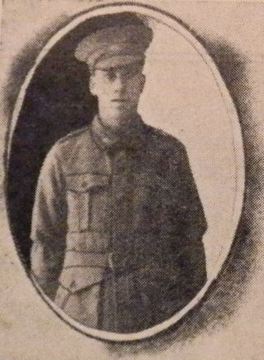
JONES, Henry Ingleson
| Service Number: | 2928 |
|---|---|
| Enlisted: | Not yet discovered |
| Last Rank: | Private |
| Last Unit: | 59th Infantry Battalion |
| Born: | Glebe, New South Wales, Australia, 1898 |
| Home Town: | Glebe, New South Wales |
| Schooling: | Not yet discovered |
| Occupation: | Carter |
| Died: | Killed in Action, Peronne, France, 2 September 1918 |
| Cemetery: |
Peronne Communal Cemetery Extension Plot V, Row C, Grave No. 20 |
| Memorials: | Australian War Memorial Roll of Honour, Glebe Roll of Honor, Glebe Superior Public School WWI Memorial, Glebe War Memorial |
World War 1 Service
| 3 Nov 1916: | Involvement Private, 2928, 59th Infantry Battalion, --- :embarkation_roll: roll_number: '20' embarkation_place: Sydney embarkation_ship: HMAT Afric embarkation_ship_number: A19 public_note: '' | |
|---|---|---|
| 3 Nov 1916: | Embarked Private, 2928, 59th Infantry Battalion, HMAT Afric, Sydney | |
| 1 Mar 1918: | Wounded AIF WW1, Private, Sent to Boulogne after a rifle wound. |
Help us honour Henry Ingleson Jones's service by contributing information, stories, and images so that they can be preserved for future generations.
Add my storyBiography contributed by Tracy Rockwell
After spending four years in the Junior Cadets, Henry Ingleson Jones (#2928, 1898-1918) was working as a carter when he enlisted in the AIF at Victoria Barracks, Paddington on the 3rd September 1916. He was a grandson of Robert and Mary Bantin. Eighteen year old Henry had brown eyes and brown hair, was 148lbs (67kg), and was just over six feet tall. On the 3rd November he embarked for active service aboard the “SS Afric” (HMAT A19), and was marched into Hurdcott AIF Camp on the 10th January 1917.
On the 25th March 1917 he proceeded to Etaples, France, where he was transferred to ‘D’ Company in the 59th Battalion. Throughout April he was in and out of hospital in Boulogne for ‘trench foot.’ On the 1st September he was charged with ‘negligently firing off a rifle’, resulting in his self-wounding with the forfeiture of 77 days pay, from which it took him almost a year to recover.
On the 1st March 1918 he received another rifle wound and was hospitalised initially in Boulogne then removed to England for convalescense at the Norfolk War Hospital, Norwich. By the 1st June he had recovered and was marched into Hurdcott AIF Camp, then transferred back to Le Havre, France where he rejoined his unit on the 20th July. He was briefly hospitalised again for Furunculosis (boils), and sent back to both Etaples and then Le Havre before rejoining his unit on the 31st August. It was just two days later that Henry was killed in action by an enemy shell. He was “buried in an isolated group of graves in line with the railway bank, half a mile north of Peronne.”
The body of Henry Ingelson Jones was later exhumed and re-interred at Peronne Communal Cemetery Extension, France, and posthumously received the British Star, the British War Medal and the Victory Medal.












